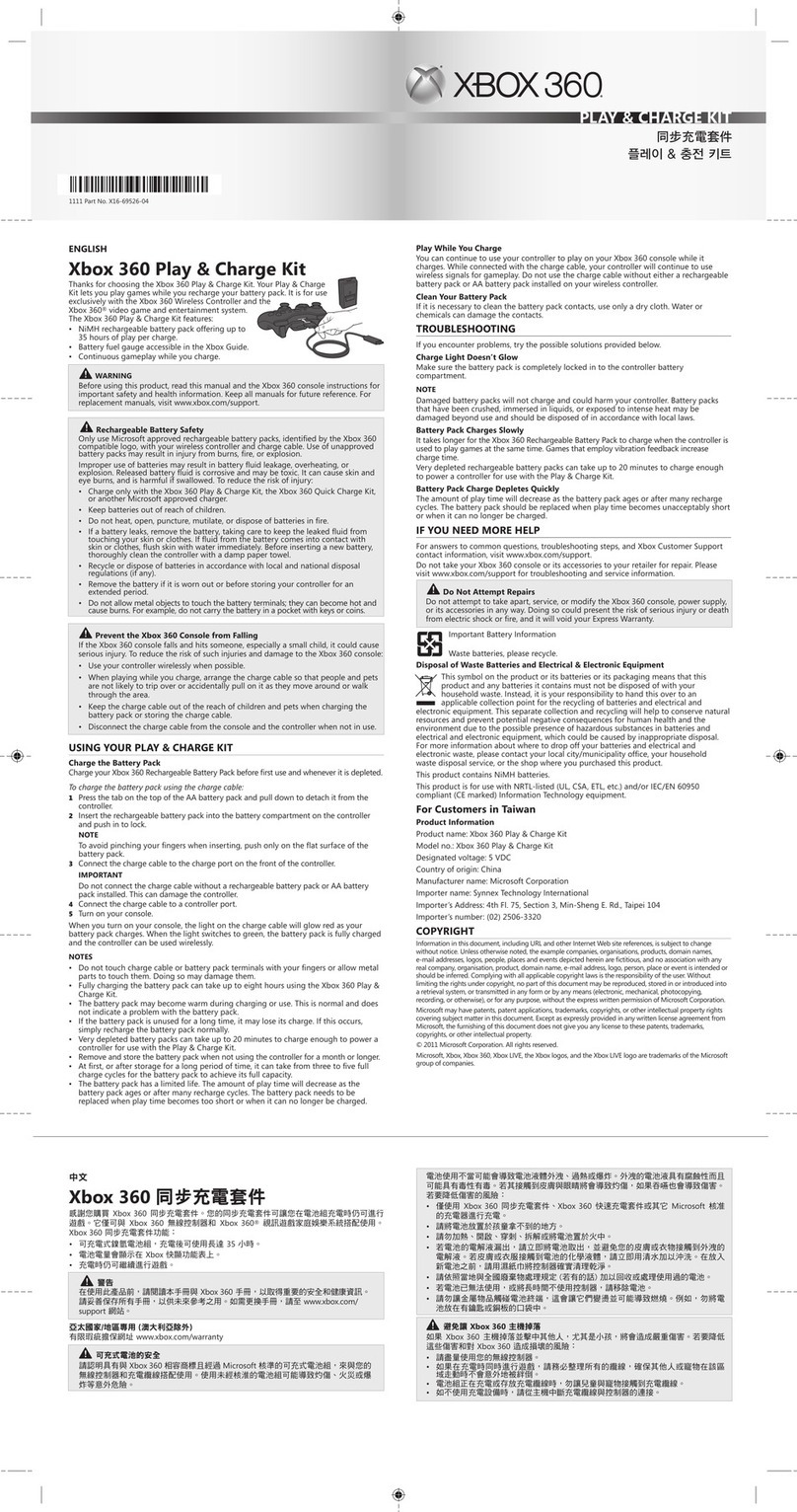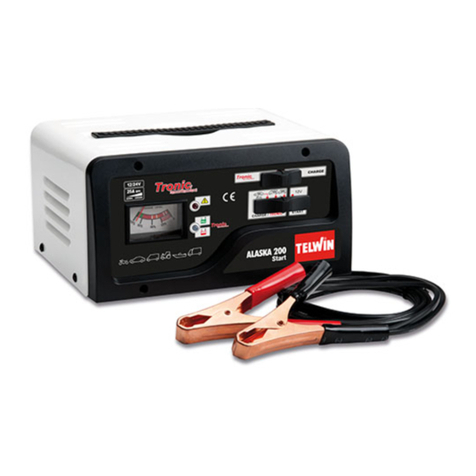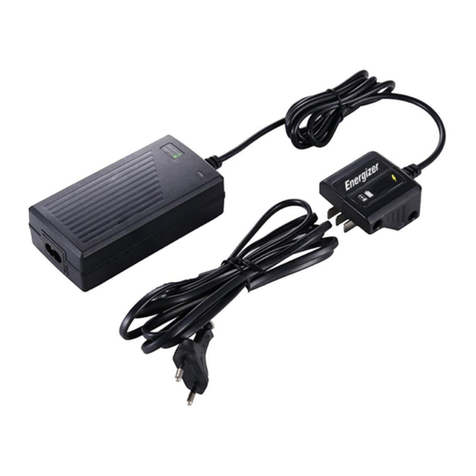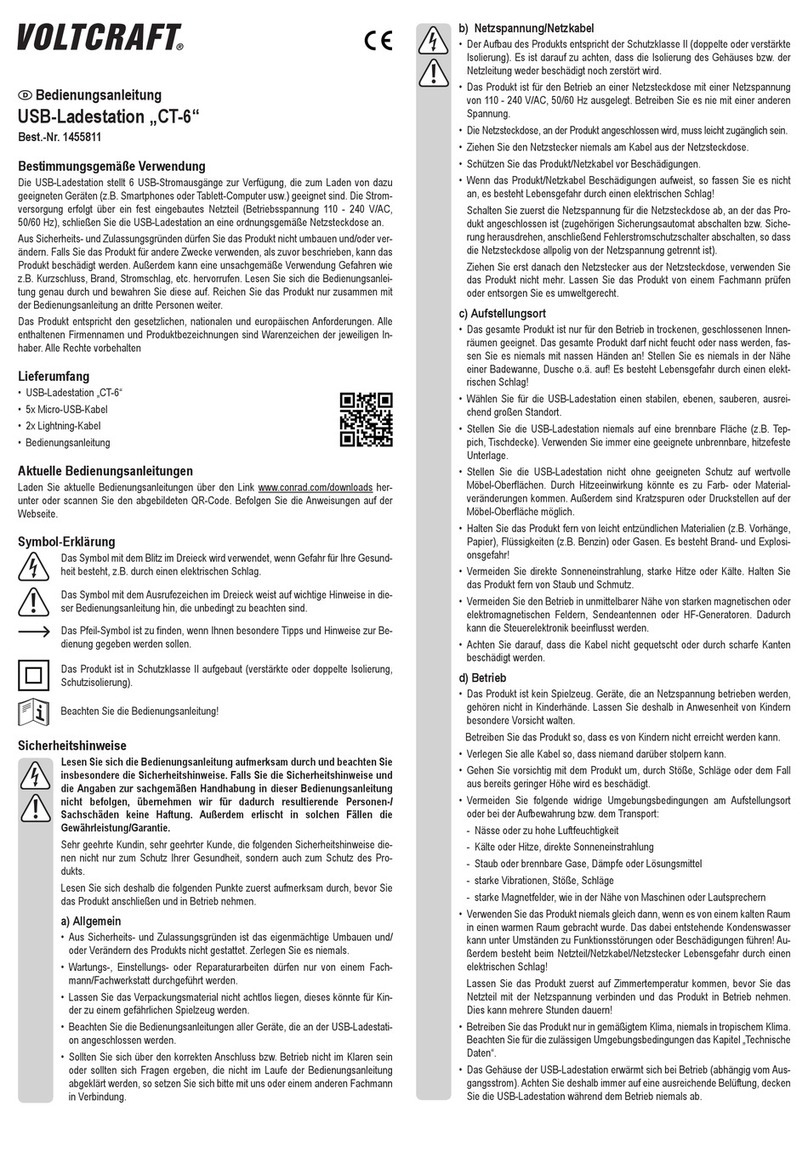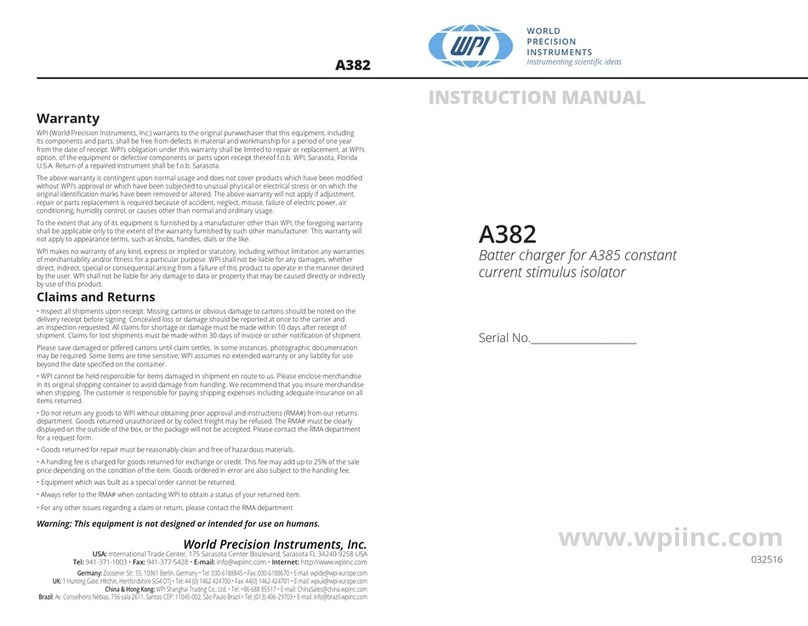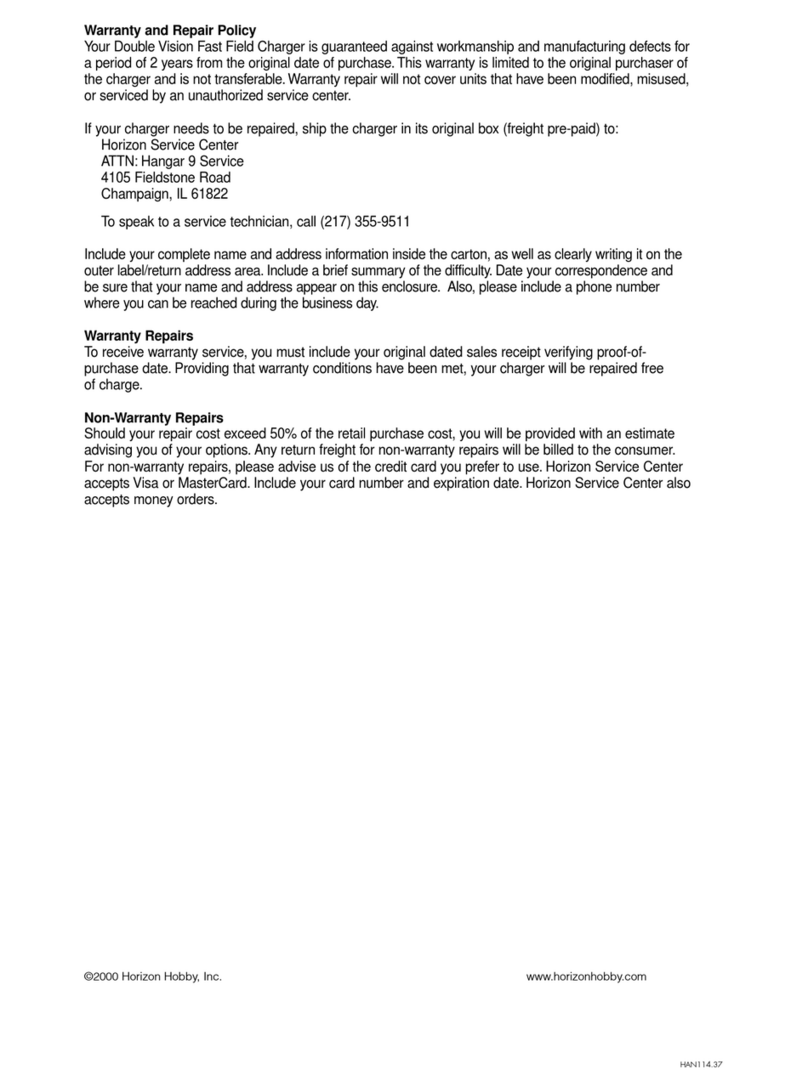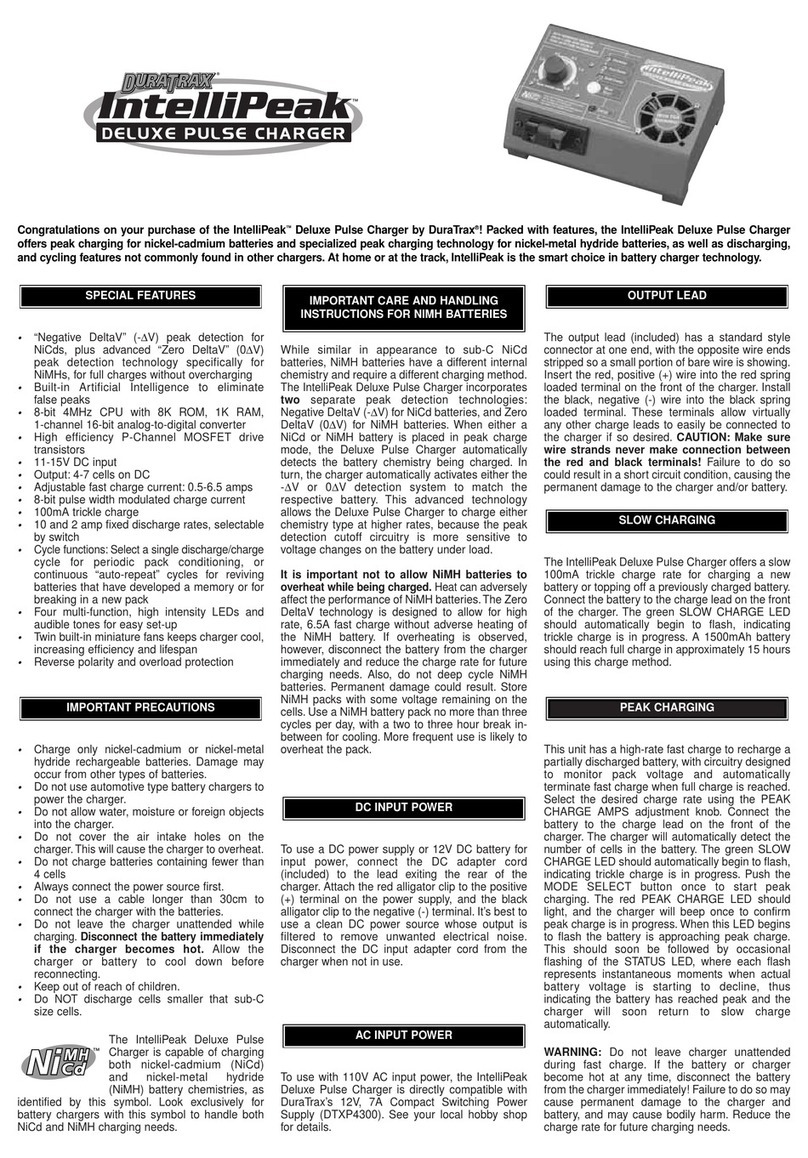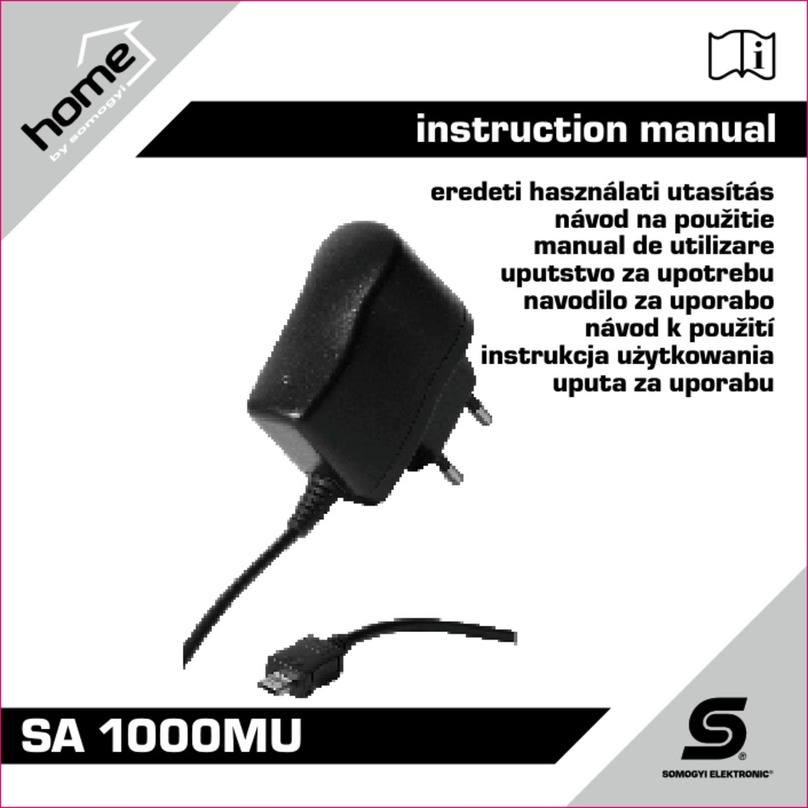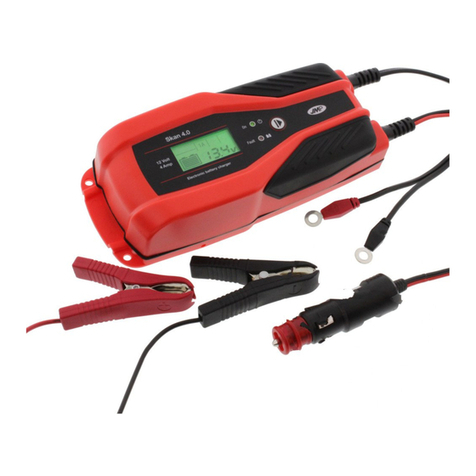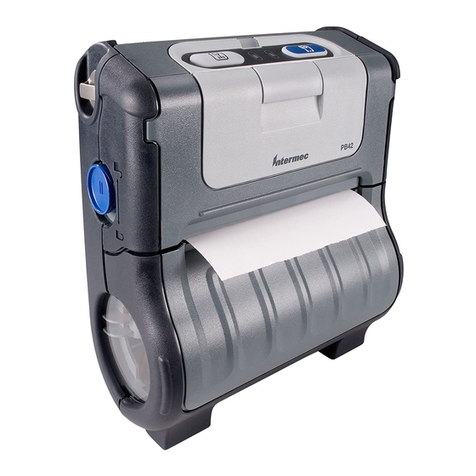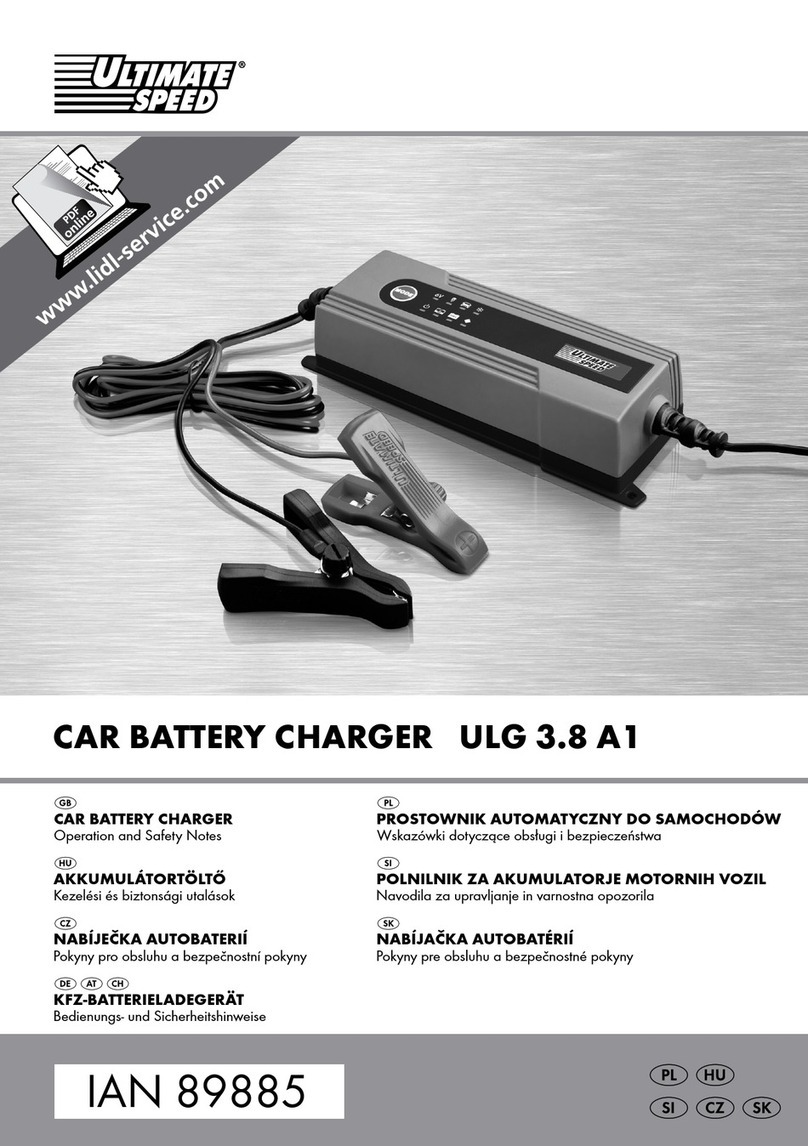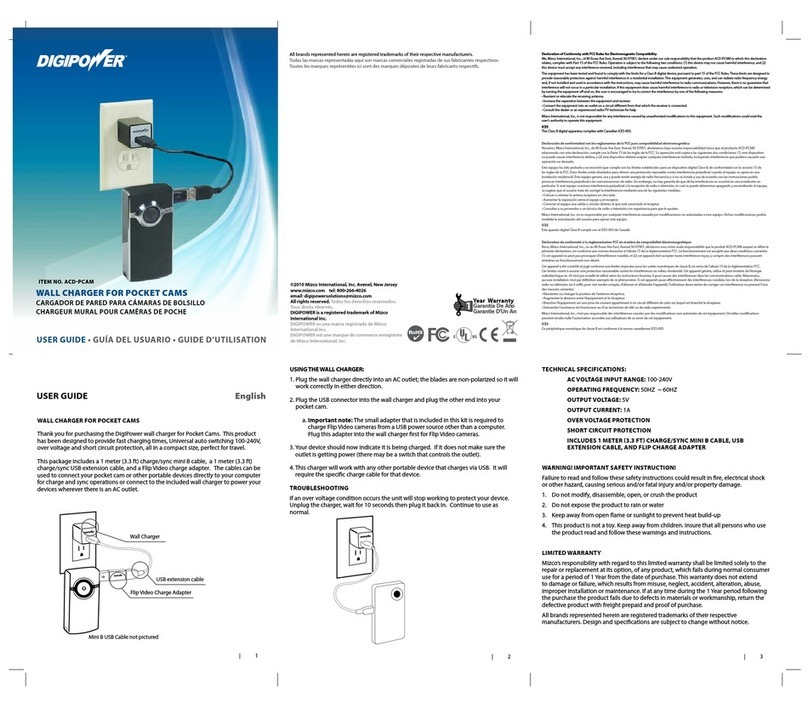Thoratec HeartMate Universal User manual

HeartMate®Universal
Battery Charger
INSTRUCTIONS FOR USE (IFU)
for Charging HeartMate12 Volt NiMH & 14 Volt Li-Ion Batteries
Corporate Headquarters
Thoratec Corporation
6035 Stoneridge Drive
Pleasanton, CA 94588
USA
Business:
Tel.: 925-847-8600
Fax: 925-847-8574
Emergencies:
800-456-1477 (USA HeartLine™)
925-847-8600 (International)
www.thoratec.com
Document # 103771.B
1/2011


HeartMate Universal Battery Charger IFU i
Table of Contents
WARNINGS & PRECAUTIONS 1
Warnings 1
Precautions 2
INTRODUCTION 4
1.0 Overview 4
2.0 Setting Up the Universal Battery Charger Prior to Use 5
2.1 Plugging In and Turning On the Charger 5
2.2 Selecting Language/Display Panel Settings 9
USING YOUR UNIVERSAL BATTERY CHARGER 12
3.0 Charging Batteries 12
3.1 Battery Charging (Overview) 12
3.2 Charging Batteries (Procedure) 15
3.3 Viewing Battery Information on the UBC Screen 18
4.0 Calibrating HeartMate Batteries 21
RESPONDING TO ADVISORY MESSAGES 24
5.0 Monitoring Performance 24
5.1 Battery-Related Advisory Messages 24
5.2 Charger-Related Advisory Messages 26
INSPECTION, CLEANING & MAINTENANCE 28
6.0 Routine Inspection and Cleaning 28
7.0 Product Disposal 29
8.0 Testing and Classification 29
APPENDICES 31
APPENDIX 1: Technical Specifications – HeartMate Universal Battery Charger
(UBC) (p/n 1440)___________ 31
APPENDIX 2: Description of English Text and Graphic Symbols Appearing on
The UBC Display Panel 33
APPENDIX 3: Graphic Symbols Found on HeartMate UBC
Labels and Labeling 34


HeartMate Universal Battery Charger IFU 1
Warnings and Cautions
Warnings
•Understanding the operating and the safety aspects of HeartMate products is essential
for safe and successful use. All users (including clinicians, patients, and caregivers)
must be trained on system operation and safety aspects before use.
•A thorough understanding of the technical principles, clinical applications, and risks
of left ventricular support is necessary before using this product. Read this entire
HeartMate Universal Battery Charger Instructions for Use (IFU) and the
corresponding HeartMate II or HeartMate XVE LVAS IFU, Operating Manual, and
/or Patient Handbook before use.
•Before using any HeartMate power accessories (Power Module/Power Base Unit,
batteries, Universal Battery Charger), all users (including clinicians, patients, and
caregivers) must be trained on their use. Manuals for HeartMate power accessories
include:
- HeartMate 12 Volt NiMH Battery Instructions for Use (IFU) (document #
103769)
- HeartMate 14 Volt Li-Ion Battery IFU (document # 103770)
- HeartMate Universal Battery Charger IFU (document # 103771)
- HeartMate Power Module IFU (document # 103772)
•HeartMate batteries must be charged prior to use. Before removing a battery from the
Universal Battery Charger (UBC), check that the battery has completed its charge or
calibration cycle, then remove the battery and check its charge level using the battery
fuel gauge. See Section 3.0, Charging Batteries.
•Ensure you are using the correct batteries before relying on them for power.
Using the wrong batteries for an incompatible system will result in pump failure.
HeartMate 14 volt lithium ion (Li-Ion) batteries are for use exclusively with the
HeartMate II LVAS. They are NOT compatible with the XVE system and cannot
power the XVE LVAS. HeartMate 12 volt nickel metal hydride (NiMH) batteries are
capable of powering both the HeartMate II and XVE LVAS (see the HeartMate 12
Volt NiMH Battery IFU).
•The HeartMate Universal Battery Charger (UBC) generates, uses, and can radiate
radio frequency energy. If not installed and used according to instructions, it may
cause harmful interference with other devices in the area. There is no guarantee that
interference will not occur in a particular installation/use of the Universal Battery
Charger (UBC). Interference can be determined by turning off/on the Universal
Battery Charger (UBC) and seeing the affect on devices in the area. If interference is
detected, attempt to correct it by:
⋅Re-orienting or moving the affected device(s).
⋅Increasing the distance between the Universal Battery Charger (UBC) and the
affected device(s).

HeartMate Universal Battery Charger IFU 2
⋅Connecting the affected device(s) to an electrical outlet different from the outlet
used to power the Universal Battery Charger (UBC).
⋅Consulting Thoratec’s Technical Services Department for advice and assistance.
•Using equipment and supplies other than those specified in this manual or sold by
Thoratec for replacement parts may affect the electromagnetic compatibility of the
Universal Battery Charger (UBC) with other devices. This may result in potential
interference between the UBC and other devices.
•The Universal Battery Charger (UBC) should not be used next to other equipment or
stacked on top of or with other equipment. The normal operation of the Universal
Battery Charger (UBC) must be verified if the charger is used in these configurations.
•Connect the Universal Battery Charger (UBC) (and any peripheral devices) only to
properly tested and grounded AC outlets dedicated to battery charger use. Do not use
an adapter for ungrounded wall outlets or multiple portable socket outlets (power
strips), or the risk of electrocution increases.
•Do not connect the Universal Battery Charger (UBC) to electrical outlets controlled
by a wall switch, or the charger may be left inoperable.
•If traveling internationally, you will need a Thoratec power cord set that is compatible
with the local voltage and that meets applicable national plug, rated voltage, rated
current, and safety agency marks and specifications. Ask your VAD Coordinator for a
Thoratec power cord set, if needed.
•Keep the Universal Battery Charger (UBC) away from water or moisture. If the UBC
has contact with water/moisture, rain/snow, shower spray, or wet surfaces, you may
get a serious electric shock or your Charger may fail to operate properly.
•Do not use the UBC near flammable anesthetic agents (such as nitric oxide), or an
explosion may occur.
•The HeartMate UBC cannot test or charge the black sealed lead acid (SLA)
HeartMate batteries originally used with the HeartMate Power Base Unit (PBU)
(catalog #2025).
Precautions
•Use only the HeartMate Universal Battery Charger (UBC) to charge HeartMate 12
volt NiMH and 14 volt Li-Ion batteries. Other battery chargers may damage
HeartMate batteries.
•Service and maintenance of the HeartMate UBC should be performed only by service
personnel who are trained and authorized by Thoratec Corporation.
•Make sure the UBC is plugged in and turned on (“I”) before placing batteries into the
pockets for charging.
•After approximately 70 uses, HeartMate batteries may need to be recalibrated. The
UBC indicates when a battery needs to be recalibrated. Calibration can take up to 12

HeartMate Universal Battery Charger IFU 3
hours, and only one battery can be calibrated at a time. Calibrate a battery as soon as
possible after being prompted to prevent a backlog of uncalibrated batteries (see
Section 4.0, Calibrating HeartMate Batteries).
•Leave a calibrating battery in the UBC for the full calibration cycle. Removing a
battery before it is fully calibrated may result in a depleted battery (the on-battery fuel
gauge will reflect this status) (see Section 4.0, Calibrating HeartMate Batteries).
•The metal contacts inside the UBC pockets should be kept clean and dry. Do not
expose contacts to water, moisture, dirt, etc. Do not touch these contacts when the
charger is connected to AC mains and turned on (“I”).
•Dirty metal contacts inside the battery charging pockets may prevent proper battery
charging, which can affect battery operation. The metal contacts inside the pockets
should be cleaned at least once a month. Unplug the UBC before cleaning. Use a lint-
free cloth or swab that has been moistened (not dripping) with rubbing alcohol. Allow
the alcohol to dry before inserting batteries into the pocket(s) for charging. See
Section 6.0, Routine Inspection and Cleaning.

HeartMate Universal Battery Charger IFU 4
INTRODUCTION
1.0 Overview
The HeartMate Universal Battery Charger (UBC) (Figure 1) is designed to
charge the HeartMate batteries used to power the HeartMate II LVAS or
HeartMate XVE LVAS during mobile operation. Specifically, the HeartMate
UBC can:
•Charge up to four HeartMate 12 volt NiMH batteries or four 14 volt Li-Ion
batteries in four hours or less (see Section 3.0, Charging Batteries).
•Monitor the need for calibration and calibrate individual HeartMate 12 volt
NiMH batteries or 14 volt Li-Ion batteries (see Section 4.0, Calibrating
HeartMate Batteries).
•Perform diagnostic testing on up to four HeartMate 12 volt NiMH batteries or
14 volt Li-Ion batteries at once (see Section 5.0, Monitoring Performance).
WARNING! A thorough understanding of the technical principles, clinical
applications, and risks of left ventricular support is necessary before using this
product. Read this entire HeartMate Universal Battery Charger Instructions for Use
(IFU) and the corresponding HeartMate II or HeartMate XVE LVAS IFU, Operating
Manual, and /or Patient Handbook before use.
CAUTION! Use only the HeartMate Universal Battery Charger (UBC) to
charge HeartMate 12 volt NiMH or 14 volt Li-Ion batteries. Other battery
chargers may damage HeartMate batteries.

HeartMate Universal Battery Charger IFU 5
2.0 Setting Up the Universal Battery Charger Before Use
Before using the HeartMate UBC (Figure 1) to charge HeartMate batteries, it
must be plugged in and turned on. In addition, you should select the
language/display panel setting best for your needs. These steps are described
below.
2.1 Plugging In and Turning On the Charger
Follow these steps for setting up the UBC:
1 If not already unpacked, carefully remove the UBC from its
product packaging. Place the charger on a flat, sturdy surface.
2 Inspect the charger for dents, chips, cracks, or other signs of
damage. Do NOT use a UBC that seems damaged. Contact your
VAD Coordinator or hospital contact person for a replacement, if
needed.
3 Examine the four battery charging pockets. Make sure the pockets
are clean and empty (no batteries), and free of dust or debris. Note:
Pay particular attention to the metal contacts inside the pockets.
Figure 1 HeartMate Universal Battery Charger (UBC) with empty charging pockets (front view)

HeartMate Universal Battery Charger IFU 6
Dirt or objects covering the metal contacts inside the pockets may
prevent proper battery charging, which can affect battery
performance.
4 Obtain the grey AC power cord from the product packaging.
5 Plug the female end of the power cord into the power entry module
in the rear of the charger (Figure 2). Make sure the cord is fully
inserted and secure.
6 Plug the male end of the power cord into a properly-tested and
grounded (3-prong) AC mains electrical outlet that is not
controlled by a light switch. Note: If traveling internationally, you
will need a Thoratec power cord set that is compatible with the
local voltage and that meets applicable national plug, rated voltage,
rated current, and safety agency marks and specifications. Ask
your VAD Coordinator for a Thoratec power cord set, if needed.
7Turn on the UBC by pressing the on/off switch in the rear of the
charger from the off (“0”) to the on (“I”) position (Figure 3). Note:
Once the charger is turned on, all lights on the front panel will turn
WARNING!
•Connect the HeartMate Universal Battery Charger (UBC) only to properly-
tested and grounded (3-prong) AC outlets. Do not use an adapter plug or
portable, multiple outlet (power strip) for ungrounded wall outlets.
•Ensure the UBC is connected to AC power and is turned “on” before
placing batteries into the pockets for charging
Figure 2 Inserting power cord into power entry module (rear of
Universal Battery Charger)

HeartMate Universal Battery Charger IFU 7
on (Figure 5), and the charger will beep once. This means the
charger is performing a self test. The test takes about 10 seconds.
When it is done, all the lights will turn off, unless there is a
problem (see Step 8).
8If the UBC detects a problem during the self test, an error message
appears on the display panel screen (Figure 4) and/or the lights
and beep will not perform as described above. Note: If you get an
error message, and/or the lights or beep are missing or do not
perform as described, refer to Section 5.0, Monitoring
Performance for how to respond to advisory messages.
OR
8If the charger passes the self test, “HeartMate CHARGER” appears
on the display panel (Figure 6). The charger is now ready for use.
Note: Any time the “HeartMate CHARGER” message is displayed,
the display panel will slowly dim, turn off for two seconds, and
then brighten again to full brightness. This helps to prolong the life
of the display (Figure 6). You may use the UBC during this time.
Figure 3 On/off switch in the "on" position ( I ) (rear of Universal Battery
Charger)
Figure 4 Sample error message (when in Graphics mode)
(close up)

HeartMate Universal Battery Charger IFU 8
Charging Pocket
Lights (green,
yellow, red)
Display Panel
Pocket Number
Button (numbers
1–4 corresponds
with pocket
location
)
Figure 5 Display panel during self test
Figure 6 "HeartMate CHARGER" message (default screen)

HeartMate Universal Battery Charger IFU 9
2.2 Selecting Language/Display Panel Settings
The display panel on the front of the HeartMate Universal Battery Charger
(UBC) displays messages about how the charger is working or about the
status of the battery(ies) in the charging pocket(s).
There are two language/display options for the display panel screen:
•English Text
•Graphic Symbols
“Graphic Symbols” is the default display mode.
Selecting the Language/Display Panel Setting
Before Using the Charger for the First Time
Follow these instructions for switching from the default (“Graphic
Symbols”) setting to the “English Text” setting before using the charger
for the first time:
1 Unpack and plug in the UBC as outlined in Section 2.1. However,
do NOT turn on the charger at this time.
2 At the same time, press and hold buttons #1 and #3 on the front
panel of the UBC (Figure 7).
Note location of
buttons #1 and
#3
Note location of
buttons #1 and
#3
Figure 7 Numbered buttons on front of charger correspond with locations of charging
pockets. Note locations of buttons #1 and #3.

HeartMate Universal Battery Charger IFU 10
3 While still holding buttons #1 and #3, turn on the UBC by pressing
the power switch from the off (“0”) to the on (“I”) position.
4 After the “English” display appears (Figure 8), release buttons #1
and #3.
5 If “English Text” is the desired display setting, press and release
the #1 button. Note: After releasing the button, the charger will
conduct a self test. If the test is successful, “HeartMate
CHARGER” will appear on the screen.
OR
5If “Graphic Symbols” is the desired setting, press and release the
#2 button to scroll down to “Graphics,” then press and release
button #1. Note: After releasing the button, the charger will
conduct a self test. If successful, “HeartMate CHARGER” will
appear on the screen.
Selecting the Language/Display Panel Setting Anytime After Startup
“Graphic Symbols” is the default display mode. Follow these instructions
for changing the display mode anytime after initial setup (see Section 2.0,
Setting Up the Universal Battery Charger (UBC) Before Use):
1 Remove all batteries from the charging pockets.
2 Turn off the UBC by pressing the on/off switch from the on (“I”)
to the off (“0”) position. Note: Do not unplug the charger.
3 At the same time, press and hold buttons #1 and #3 on the front
panel of the UBC.
4 While still holding buttons #1 and #3, turn on the charger by
pressing the power switch from the off (“0”) to the on (“I”)
position.
5 After the display screen appears (Figure 9), release buttons #1 and
#3). The UBC will power up.
Figure 8 Display panel showing English language display mode option

HeartMate Universal Battery Charger IFU 11
6 Use the #2 button to scroll down to the desired language/display
panel setting.
7 When the desired language/display panel setting appears on the
screen, press and release the #1 button. After releasing the button,
the charger will conduct a self test. If the test is successful,
“HeartMate CHARGER” will appear on the screen.
8Repeat Steps 1 – 7 any time after initial set up to select or change
the desired language/display panel setting.
Note: Avoid covering or blocking the vents on the top of the UBC during
use. Covering or blocking the vents may affect device performance.
Figure 9 Display panel showing current language/display setting
(English language)

HeartMate Universal Battery Charger IFU 12
USING YOUR UNIVERSAL BATTERY CHARGER
3.0 Charging Batteries
3.1 Battery Charging (Overview)
The HeartMate Universal Battery Charger (UBC) can charge up to four
HeartMate 12 volt NiMH or 14 volt Li-Ion batteries at the same time. It
takes up to four hours to charge from one to four batteries, depending on
the charge status of the battery(ies) being charged. Be sure to plan battery
use and charging with the four-hours in mind.
For best battery performance, leave charged batteries in the charging
pockets until ready for use. Leaving charged batteries in the charger will
not damage them.
HeartMate 12 volt NiMH batteries and 14 volt Li-Ion batteries utilize a
“smart” technology that measures available battery power and counts
battery usage/charge cycles. Once a battery is placed into a charging
pocket (Figure 10), the UBC immediately checks that battery’s status by
reading the battery’s on board computer chip. Information about the
battery (available power and total number of use/charge cycles) can be
viewed on the UBC’s display panel by pressing the number button for that
pocket (see Section 3.3, Viewing Battery Information on the UBC Screen).
Figure 10 Batteries inserted into Universal Battery Charger pockets #2 and #4. Note
yellow lights indicate charge status of batteries (yellow = charging).
Batteries
in Pockets
#2 and #4

HeartMate Universal Battery Charger IFU 13
Depending on the status of the battery, one of three lights (yellow, green,
or red) located near the number button for this pocket will come on
(Figure 11). A steady yellow light means that the battery is actively
charging. Green means the battery is charged and ready for use. Red
means the battery is defective or that there is a problem with the charger.
See Table 1 for a complete description of charger pocket light color
codes.
UBC Charger Pocket Light Indicators
Light Color Status/Meaning
Green
Battery is charged and ready for use
Yellow
Battery is undergoing test or charge
Yellow (Blinking)
Battery requires calibration cycle
Red
Battery or charging pocket is defective,
Do not use battery*
Table 1 Color codes for charging pocket lights
* Before assuming that a battery is defective, first remove it from the pocket
and then reinsert it into the same pocket. If again there is a red light (or no
light), insert the battery into a different pocket. Try cleaning the metal
contact on the batteries and inside the pocket (let them dry). If there
continues to be is a red light (or no light), the battery is defective. Do not
Figure 11 Charge status lights (green, yellow, red) for charging pockets 1 - 4

HeartMate Universal Battery Charger IFU 14
use it. Contact your VAD Coordinator or hospital contact person for help
and for a replacement, if needed. See Section 5.0, Monitoring
Performance for information on advisory messages and troubleshooting,
including how to read alarm codes when a red light comes on
WARNING!
•Ensure you are using the correct batteries before relying on them for
power. Using the wrong batteries for an incompatible system will result in
pump failure.
•The HeartMate 12 volt nickel metal hydride (NiMH) batteries can power
both the HeartMate II LVAS and the HeartMate XVE LVAS.
•The HeartMate14 volt lithium ion (Li-Ion) batteries are NOT
interchangeable between the HeartMate II and the HeartMate XVE
systems. HeartMate 14 volt Li-Ion batteries are for use exclusively with the
HeartMate II LVAS. They are NOT compatible with the XVE system and
cannot power the XVE LVAS. Do NOT use HeartMate 14 volt Li-Ion
batteries with the HeartMate XVE LVAS.

HeartMate Universal Battery Charger IFU 15
3.2 Charging Batteries (Procedure)
Follow these instructions for charging HeartMate 12 volt NiMH batteries
and 14 volt Li-Ion batteries:
1Obtain one or more HeartMate 12 volt NiMH or 14 volt Li-Ion
batteries.
2Place one of the HeartMate batteries into one of the four battery
charging pockets, with the battery fuel gauge on the top and facing
forward (Figure 12). Note: Do not force a battery into a charging
pocket. Batteries will fit only one way into a pocket (with the
battery’s battery fuel gauge at the top and facing forward as shown
in Figure 12). A beep and one of the pocket lights coming on (red,
yellow, or green) confirms the battery is properly placed in the
pocket.
3 After hearing the beep, look at the three lights (yellow, green, and
red) next to the number button for this pocket (Figure 13). Note:
The UBC has four charging pockets. Numbers 1 – 4 on the front
panel of the charger correspond to the location of each pocket. For
example, “1” on the panel stands for the front left pocket; “2”
stands for the front right pocket; “3” stands for the rear left; and
“4” stands for the rear right pocket.
CAUTION!
•Do not attempt to test or charge non-HeartMate batteries in the
HeartMate Universal Battery Charger (UBC). Doing so may
damage the charger or the batteries, or injure the user.
•Do not attempt to test or charge the black sealed lead acid (SLA)
HeartMate batteries originally used with the HeartMate Power Base
Unit (PBU) (catalog #2025). Doing so may damage the charger or
the batteries, or injure the user.
Figure 12 Batteries inserted into charging pockets #2 and #4

HeartMate Universal Battery Charger IFU 16
4 Identify which of the three lights (yellow, green, or red) comes on
for this pocket.
5 If the yellow light comes on, the battery is actively charging. Do
nothing with the battery. Leave the battery in the pocket to
continue charging and skip to Step 7. If a blinking yellow light is
observed, see section 4.0 Calibrating HeartMate Batteries. Note:
The yellow light will remain on until the battery becomes charged.
Once the battery becomes charged, the yellow light turns off and
the green light comes on.
OR
5 If the green light comes on, the battery is already charged and
ready for use. Either remove the battery for immediate use, or
leave the battery in the pocket until needed. Note: Leaving charged
batteries in the charger will not damage them.
OR
5 If the red light comes on (or no light at all), there is a problem with
the battery or the charging pocket. Note: Remove the battery and
reinsert it into the same pocket. If again there is a red light (or no
light), insert the battery into a different pocket. If the battery
cannot be charged in a different pocket, the battery is defective. Do
not use the defective battery. Contact your VAD Coordinator or
hospital contact person for help and for a replacement, if needed.
See Section 5.0, Monitoring Performance for information on
advisory messages and troubleshooting, including how to read
alarm codes when a red light comes on.
Figure 13 Charge status lights. Note yellow light for pocket #1. In this
case, the battery in pocket #1 is charging.
Table of contents
